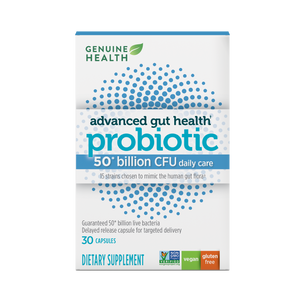5 Reasons Your Probiotic Isn’t Working

You buy probiotics thinking they'll have a huge impact on how you feel. You take them for a week or two, and… nothing. You don’t feel a difference. Or worse, you feel more bloated and your digestion feels funnier than when you started.
The research is clear, probiotics can improve your health1. But maybe we should clarify that to say “some,” because the truth is, some probiotics work better than others.
How can this be? This question intrigued us, so we spent a lot of time thinking about how to make a really great probiotic that would actually make a difference in how you feel.
And during this time we learned that if your probiotic isn’t working for you, it could be because it contains an ingredient that you’re allergic to, the bacteria aren’t making it to your gut alive, or maybe it’s just not the right formula for you.
Here’s how to troubleshoot why your probiotic may not be working for you, and how to find a probiotic that will.
We’ve all been there at some point, when we’ve had to take antibiotic. But when we’re recovering from a bout of antibiotics, we’ll benefit from a different probiotic formula than if we were just buying a probiotic for daily support. Our gut contains thousands of different species of probiotic bacteria, so in most cases, for most of us, the most effective probiotics contain a variety of different strains of bacteria that will repopulate and replenish more of the good guys. In fact, in 75% of the cases where studies evaluated multi-species probiotic formulas vs. individual species, the multi-strain formula worked better!
But back to the antibiotic point: a probiotic that’s made with one strain could be more effective for an acute situation, like when we’ve just come off a round of antibiotics, but if the goal is everyday support, the best bet is to go with a multi-strain probiotic formula.
The World Health Organization (WHO) defines probiotics as live micro-organisms that, when administered in adequate amounts, confer a health benefit on the host. The key words here are “live” and “benefit” because in order for you to feel a benefit, your probiotics must be living! How can you tell? A good place to start is to make sure that your probiotic has a guaranteed CFU at expiry – this will tell you the number of bacteria that are guaranteed to be living by the time the probiotic has expired.
Also, many probiotics are sold in bottles, which exposes the capsules to humidity and ambient air every time the bottle is opened. Instead, look for a shelf stable probiotic with humidity-controlled packaging, like a blister pack for example.
Probiotic bacteria are delicate, living creatures. In order to provide a benefit to you, they must make a harrowing journey through your stomach’s harsh acidic environment and reach your gut alive. But this is hard to do! Research has found that if you take probiotics orally and without a capsule, many strains of the probiotics won’t make it to your gut alive. That’s where a capsule comes in – to protect the probiotics from your stomach acid. Look for a probiotic encapsulated in a delayed-release, plastic free capsule that will deliver the bacteria to your gut – alive and ready to get to work.
So you’ve bought a probiotic with multiple strains, great! But it doesn’t feel like it’s doing a good job…. It could be because your multi-strain probiotic doesn’t contain balanced strains. We’ve spent a lot of time looking at probiotic formulas, and have found that many multi-strain formulas are largely stacked with L. acidophilus and L. rhamnosus-based – these are two resident strains that are limited in their ability to contribute without other species to assist them. Also watch out for “proprietary” blends of probiotics, because manufacturers could be loading them with only one or two strains. Look for a probiotic that lists all strains and their amounts on the label for complete transparency.
Many of us think that a probiotic can help to solve all our woes. But probiotics can’t do it all on their own. We need to create the right environment for them to thrive, and that’s where prebiotics come in (prebiotics are the food for your probiotics). The problem is that most prebiotics can cause digestive upset (no thanks!). But science has just discovered that a class of phytonutrients called polyphenols can provide a prebiotic benefit – best of all, without any bloating or digestive upset! Look for a prebiotic superfood that you can take alongside your probiotic.
You want a probiotic that works, and we get that. At Genuine Health, we take our products very seriously. We spent a lot of time creating advanced gut health probiotic so that it would actually make a difference in how you feel. We’re really proud of it because we worked backwards to make sure that it delivers more hearty and healthy bacteria to your gut.
We start by selecting 15 strains of both resident and transient strains of lactobacilli and bifidobacteria, and assemble them in a balanced formula that contains enough CFU of each to provide a benefit.
Then, we triple clean them to remove any weak strains and ensure that only the heartiest and healthiest remain.
Then we put them in a delayed-release, plastic-free capsule that’s been shown to deliver up to 10x the bacteria to the gut. And all advanced gut health formulas are shelf stable and packed in a humidity-resistant blister pack, and are vegan and free of allergens like gluten, wheat, dairy, nuts, fish, eggs and sulphites.
But we don’t stop there. We also believe that it’s important to create the right environment for probiotic bacteria to thrive. That’s why we made fermented organic gut superfoods+, a prebiotic superfood made with 22 fully fermented superfoods and prebiotics to nourish a healthy and thriving gut ecology for whole body benefits.
1Taibi, et al. Practical approaches to probiotics use. Appl Physiol Nutr Metab. 2014 Aug;39(8):980-6
The research is clear, probiotics can improve your health1. But maybe we should clarify that to say “some,” because the truth is, some probiotics work better than others.
How can this be? This question intrigued us, so we spent a lot of time thinking about how to make a really great probiotic that would actually make a difference in how you feel.
And during this time we learned that if your probiotic isn’t working for you, it could be because it contains an ingredient that you’re allergic to, the bacteria aren’t making it to your gut alive, or maybe it’s just not the right formula for you.
Here’s how to troubleshoot why your probiotic may not be working for you, and how to find a probiotic that will.
1. It’s not the right probiotic for you
We’ve all been there at some point, when we’ve had to take antibiotic. But when we’re recovering from a bout of antibiotics, we’ll benefit from a different probiotic formula than if we were just buying a probiotic for daily support. Our gut contains thousands of different species of probiotic bacteria, so in most cases, for most of us, the most effective probiotics contain a variety of different strains of bacteria that will repopulate and replenish more of the good guys. In fact, in 75% of the cases where studies evaluated multi-species probiotic formulas vs. individual species, the multi-strain formula worked better!
But back to the antibiotic point: a probiotic that’s made with one strain could be more effective for an acute situation, like when we’ve just come off a round of antibiotics, but if the goal is everyday support, the best bet is to go with a multi-strain probiotic formula.
What about researched strains?
Lots of companies are out there talking about their research-proven strains. Having a strain that is clinically validated is great – just check to make sure that it is proven to provide the benefit that you are looking for!
2. The bacteria aren’t alive
The World Health Organization (WHO) defines probiotics as live micro-organisms that, when administered in adequate amounts, confer a health benefit on the host. The key words here are “live” and “benefit” because in order for you to feel a benefit, your probiotics must be living! How can you tell? A good place to start is to make sure that your probiotic has a guaranteed CFU at expiry – this will tell you the number of bacteria that are guaranteed to be living by the time the probiotic has expired.
Also, many probiotics are sold in bottles, which exposes the capsules to humidity and ambient air every time the bottle is opened. Instead, look for a shelf stable probiotic with humidity-controlled packaging, like a blister pack for example.
3. The bacteria aren’t getting to your gut
Probiotic bacteria are delicate, living creatures. In order to provide a benefit to you, they must make a harrowing journey through your stomach’s harsh acidic environment and reach your gut alive. But this is hard to do! Research has found that if you take probiotics orally and without a capsule, many strains of the probiotics won’t make it to your gut alive. That’s where a capsule comes in – to protect the probiotics from your stomach acid. Look for a probiotic encapsulated in a delayed-release, plastic free capsule that will deliver the bacteria to your gut – alive and ready to get to work.
4. It doesn’t contain balanced strains
So you’ve bought a probiotic with multiple strains, great! But it doesn’t feel like it’s doing a good job…. It could be because your multi-strain probiotic doesn’t contain balanced strains. We’ve spent a lot of time looking at probiotic formulas, and have found that many multi-strain formulas are largely stacked with L. acidophilus and L. rhamnosus-based – these are two resident strains that are limited in their ability to contribute without other species to assist them. Also watch out for “proprietary” blends of probiotics, because manufacturers could be loading them with only one or two strains. Look for a probiotic that lists all strains and their amounts on the label for complete transparency.
5. You’re not taking your probiotic with polyphenols & prebiotics
Many of us think that a probiotic can help to solve all our woes. But probiotics can’t do it all on their own. We need to create the right environment for them to thrive, and that’s where prebiotics come in (prebiotics are the food for your probiotics). The problem is that most prebiotics can cause digestive upset (no thanks!). But science has just discovered that a class of phytonutrients called polyphenols can provide a prebiotic benefit – best of all, without any bloating or digestive upset! Look for a prebiotic superfood that you can take alongside your probiotic.
This is the stuff that really excites us.
You want a probiotic that works, and we get that. At Genuine Health, we take our products very seriously. We spent a lot of time creating advanced gut health probiotic so that it would actually make a difference in how you feel. We’re really proud of it because we worked backwards to make sure that it delivers more hearty and healthy bacteria to your gut.
We start by selecting 15 strains of both resident and transient strains of lactobacilli and bifidobacteria, and assemble them in a balanced formula that contains enough CFU of each to provide a benefit.
Then, we triple clean them to remove any weak strains and ensure that only the heartiest and healthiest remain.
Then we put them in a delayed-release, plastic-free capsule that’s been shown to deliver up to 10x the bacteria to the gut. And all advanced gut health formulas are shelf stable and packed in a humidity-resistant blister pack, and are vegan and free of allergens like gluten, wheat, dairy, nuts, fish, eggs and sulphites.
But we don’t stop there. We also believe that it’s important to create the right environment for probiotic bacteria to thrive. That’s why we made fermented organic gut superfoods+, a prebiotic superfood made with 22 fully fermented superfoods and prebiotics to nourish a healthy and thriving gut ecology for whole body benefits.
1Taibi, et al. Practical approaches to probiotics use. Appl Physiol Nutr Metab. 2014 Aug;39(8):980-6


































































